Introduction: Gallbladder cancer (GBC) is the fifth most common cancer of the gastrointestinal
tract and the most common cancer of the biliary tract. Obesity has been independently
associated with gallbladder cancer, being the risk of GBC 1.6 times higher in people with
obesity.
Clinical case: We report a case of a 54 year-old woman with a BMI of 48 and asymptomatic
cholelithiasis, submitted to Roux-en-Y laparoscopic gastric bypass and cholecystectomy. The
gallbladder’s histology revealed chronic cholecystitis with gallstones and intraepithelial
malignant foci with carcinoma in situ. The cystic duct didn’t have lesions, there was no vascular
or neural invasion, and the surgical margins were free.
Discussion: Incidentally discovered gallbladder cancer (IGBC) is defined as the gallbladder
cancer (GBC) diagnosed during or after the cholecystectomy done for unsuspected benign
gallbladder disease. The strongest risk factor of gallbladder cancer is a history of cholelithiasis,
and the risk increases with gallstone size, chronicity, and burden of symptoms. The current
hypothesis establishes that chronic inflammation of the bile duct tissue accumulates
successive genomic mutations that lead to malignant transformation. Early-stage gallbladder
cancer is commonly discovered after cholecystectomy and review of the surgical pathology
specimen.
Conclusion: Gallbladder cancer detection often occurs as an incidental finding on imaging or
after a surgical procedure. Majority of GBC patients have associated gallstones and
laparoscopic cholecystectomy (LC) is the most common procedure performed for benign
gallbladder disease. With the advent of ultrasonography, more patients are being diagnosed
with gallstones and are being subjected to cholecystectomy. IGBC is found in 0.2–2.9 % of all
cholecystectomies done for gallstone disease. It represents 27–41 % of all GBC. Patients with
IGBC having Tis and T1a stage, with negative cystic duct margin can be treated by simple
cholecystectomy alone.
Abstract ID
AA092




